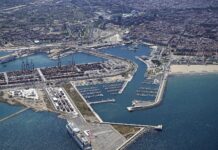
Jawaharlal Nehru Port Trust (JNPT), also known as Nhava Sheva, is putting in place the infrastructure required to align its operations with India’s Dedicated Freight Corridor (DFC), aiming to go live from the port at the end of this year.
Towards that goal, the port authority has opened a new common rail yard for all terminals in the harbour.
“JNPA is the first port to be completely DFC compliant. DFC compatible rail tracks are being laid from New Delhi to JNPA, and it has been decided to locate a loading yard on JNPA premises,” the port said in a statement. “The Long-haul Common Yard consists of three lines of 1500 meters for double-stack container trains, out of which two are top-wired ballastless lines meant for loading and unloading of containers, and one is for engine turnaround of electric locomotives.”
The upgraded infrastructure was inaugurated by Indian Ports & Shipping Minister Sarbananda Sonowal yesterday (15 May). “The dedication and contribution of JNPA over the last three decades has resulted in it being a globally recognized port,” noted Sonowal.
“There are several ongoing infrastructural and other developmental projects, green port initiatives at JNPA that will result in an increase in JN Port’s business and eventually boost the nation’s EXIM [export-import] trade,” said JNPA chairman Sanjay Sethi, speaking at the event. “All our projects align with the ministry’s initiatives enabling multimodal connectivity, reduction in logistics cost and ease of doing business.”
Container terminals on the western coast of India are upbeat about the speedy rail link, as service reliability has been a major concern for container rail companies due to infrastructure shortcomings and the government generally according to priority to passenger train services.
Besides addressing such inherent issues, DFC will allow terminals to expand their double-stack train services already being pitched as an attractive tool to compete with trucking, the predominant mode of inland movement.
“JNPA is committed to contributing to the nation’s economic growth trajectory,” the port authority noted. “The port has been consistently working to break down barriers to the movement of goods and services and support deeper integration into global supply chains by providing the best mechanisms and being the port of choice.”
Mundra Port and APM Terminals Pipavav have already become connected to the DFC network, with the opening of some stretches in a phased manner.
“Double-stack trains are truly a benefit to the logistics industry as it ensures fast, safe, and pollution-free movement of cargoes,” Jakob Friis Sorensen, managing director of APMT Pipavav, said in a previous statement.
Thanks to a strong rebound in Indian export trade, JNPT ended the fiscal year 2021-22 with a new throughput high, handling 5.68 million TEU. However, the port needs to work harder on raising its rail volumes to get closer to government target goals.
Jenny Daniel
India correspondent
Contact email: j.daniel@container-news.com








